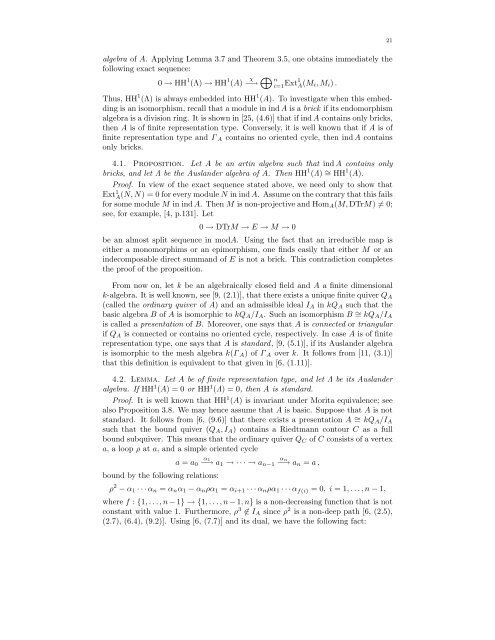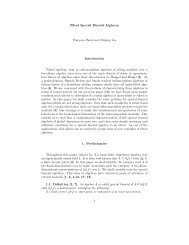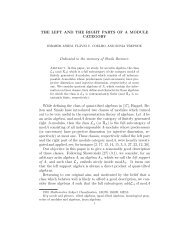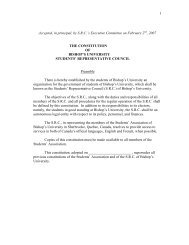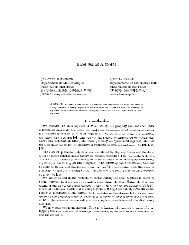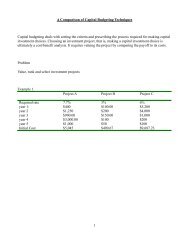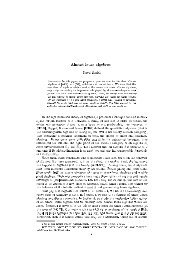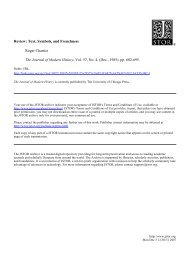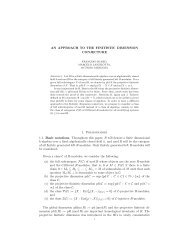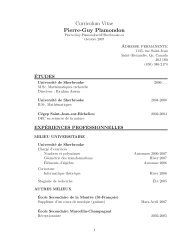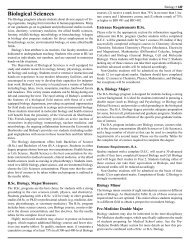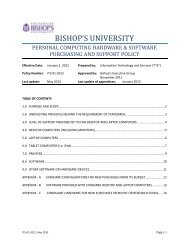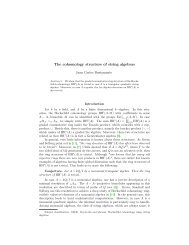Hochschild Cohomology and Representation-finite Algebras Ragnar ...
Hochschild Cohomology and Representation-finite Algebras Ragnar ...
Hochschild Cohomology and Representation-finite Algebras Ragnar ...
Create successful ePaper yourself
Turn your PDF publications into a flip-book with our unique Google optimized e-Paper software.
21<br />
algebra of A. Applying Lemma 3.7 <strong>and</strong> Theorem 3.5, one obtains immediately the<br />
following exact sequence:<br />
0 → HH 1 (Λ) → HH 1 χ<br />
(A) −→ ⊕ n<br />
i=1 Ext1 A (M i,M i ) .<br />
Thus, HH 1 (Λ) is always embedded into HH 1 (A). To investigate when this embedding<br />
is an isomorphism, recall that a module in ind A is a brick if its endomorphism<br />
algebra is a division ring. It is shown in [25, (4.6)] that if ind A contains only bricks,<br />
then A is of <strong>finite</strong> representation type. Conversely, it is well known that if A is of<br />
<strong>finite</strong> representation type <strong>and</strong> Γ A contains no oriented cycle, then ind A contains<br />
only bricks.<br />
4.1. Proposition. Let A be an artin algebra such that ind A contains only<br />
bricks, <strong>and</strong> let Λ be the Ausl<strong>and</strong>er algebra of A. ThenHH 1 (Λ) ∼ = HH 1 (A).<br />
Proof. In view of the exact sequence stated above, we need only to show that<br />
Ext 1 A (N,N) = 0 for every module N in ind A. Assume on the contrary that this fails<br />
for some module M in ind A. ThenM is non-projective <strong>and</strong> Hom A (M,DTrM) ≠0;<br />
see, for example, [4, p.131]. Let<br />
0 → DTrM → E → M → 0<br />
be an almost split sequence in modA. Using the fact that an irreducible map is<br />
either a monomorphims or an epimorphism, one finds easily that either M or an<br />
indecomposable direct summ<strong>and</strong> of E is not a brick. This contradiction completes<br />
the proof of the proposition.<br />
From now on, let k be an algebraically closed field <strong>and</strong> A a <strong>finite</strong> dimensional<br />
k-algebra. It is well known, see [9, (2.1)], that there exists a unique <strong>finite</strong> quiver Q A<br />
(called the ordinary quiver of A) <strong>and</strong> an admissible ideal I A in kQ A such that the<br />
basic algebra B of A is isomorphic to kQ A /I A . Such an isomorphism B ∼ = kQ A /I A<br />
is called a presentation of B. Moreover, one says that A is connected or triangular<br />
if Q A is connected or contains no oriented cycle, respectively. In case A is of <strong>finite</strong><br />
representation type, one says that A is st<strong>and</strong>ard, [9, (5.1)], if its Ausl<strong>and</strong>er algebra<br />
is isomorphic to the mesh algebra k(Γ A )ofΓ A over k. It follows from [11, (3.1)]<br />
that this definition is equivalent to that given in [6, (1.11)].<br />
4.2. Lemma. Let A be of <strong>finite</strong> representation type, <strong>and</strong> let Λ be its Ausl<strong>and</strong>er<br />
algebra. If HH 1 (A) =0or HH 1 (Λ) =0,thenA is st<strong>and</strong>ard.<br />
Proof. It is well known that HH 1 (A) is invariant under Morita equivalence; see<br />
also Proposition 3.8. We may hence assume that A is basic. Suppose that A is not<br />
st<strong>and</strong>ard. It follows from [6, (9.6)] that there exists a presentation A ∼ = kQ A /I A<br />
such that the bound quiver (Q A ,I A ) contains a Riedtmann contour C as a full<br />
bound subquiver. This means that the ordinary quiver Q C of C consists of a vertex<br />
a, aloopρ at a, <strong>and</strong> a simple oriented cycle<br />
α<br />
a = a<br />
1<br />
α<br />
0 −→ a1 →···→a<br />
n<br />
n−1 −→ an = a,<br />
bound by the following relations:<br />
ρ 2 − α 1 ···α n = α n α 1 − α n ρα 1 = α i+1 ···α n ρα 1 ···α f(i) =0,i=1,...,n− 1,<br />
where f : {1,...,n− 1} →{1,...,n− 1,n} is a non-decreasing function that is not<br />
constant with value 1. Furthermore, ρ 3 ∉ I A since ρ 2 is a non-deep path [6, (2.5),<br />
(2.7), (6.4), (9.2)]. Using [6, (7.7)] <strong>and</strong> its dual, we have the following fact:


